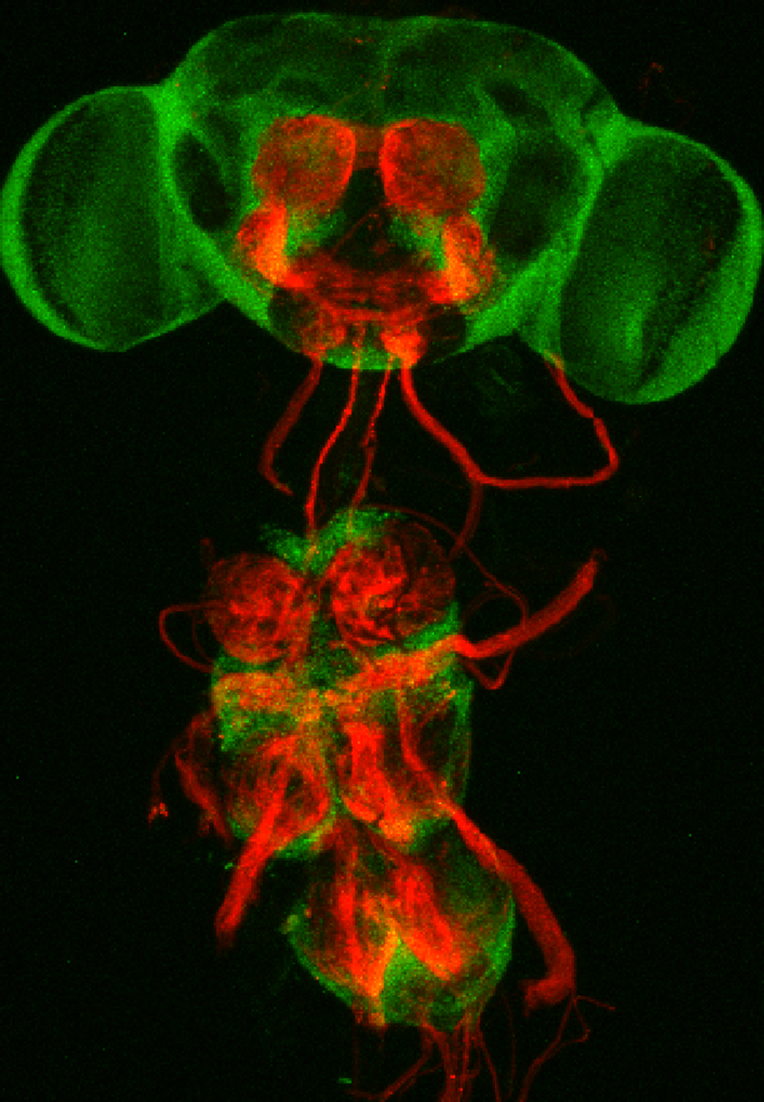ORIP-Funded Investigator Earns Recognition for Decades of Scientific Contributions

Dr. Hugo Bellen, Distinguished Service Professor, Molecular and Human Genetics, Baylor College of Medicine (BCM), was recently recognized as the recipient of the 2024 Gruber Genetics Prize. The award was sponsored by the Gruber Foundation at Yale University, which honors individuals in the fields of cosmology, genetics, neuroscience, justice, and women’s rights. The Genetics Prize is presented to a leading scientist, or up to three, in recognition of groundbreaking contributions to any realm of genetics research.
Dr. Bellen, an ORIP-funded researcher (R24OD031447, R24OD022005), uses the fruit fly (Drosophila melanogaster) as a model to explore the biological mechanisms that underlie neuronal development and function (Figure 1). His team is working to elucidate pathogenic mechanisms of neurological diseases, including rare diseases. Additionally, Dr. Bellen’s team, in collaboration with Dr. Oguz Kanca, is developing new tools and technologies for genetics studies.
Dr. Bellen’s colleagues underscored the significance of this prestigious award, both for him and the fruit fly research community. “I think the whole field took this award as a celebration for the recognition of the power of this model organism, and Hugo’s work to spearhead that field,” reflected Dr. Shinya Yamamoto, Associate Professor, Department of Molecular and Human Genetics, BCM. “Hugo’s award recognizes his continuous efforts to generate these tools and technologies, making these available for the community, as well as really showing the power of how one can be very creative in combining these tools to tackle medical mysteries. This was a career-wide recognition for him.”
Dr. Bellen has dedicated his career to using the fruit fly as a model to explore the development and function of the nervous system and study underlying mechanisms of human diseases. Fruit flies offer several advantages for research, including their short life span, rapid reproduction cycle, distinct anatomic features, and simple genetic profile. In a recent Nature Reviews Genetics article, Dr. Bellen and his colleagues convey the importance of nonmammalian model organisms—including fruit flies, nematode worms (Caenorhabditis elegans), and zebrafish (Danio rerio)—to diagnose and develop new treatments for genetic diseases.1

By creating transgenic Drosophila lines, Dr. Bellen’s team is gaining insight into how changes in the expression of specific genes affect phenotype, which can help researchers understand the function of these genes in humans (Figure 2). These lines are made available to the community through the Bloomington Drosophila Stock Center (BDSC) at Indiana University, which is supported by ORIP (P40OD018537). Dr. Kevin Cook, a co-principal investigator at BDSC, underscored the impact of Dr. Bellen’s contributions to the Center: “We take the resources that Hugo’s laboratory is generating and distribute them to the world; there are studies everywhere using the resources that they have generated,” Dr. Cook emphasized. “There are uses for these stocks that we had never imagined. It’s really a phenomenal accomplishment.”
Dr. Bellen’s work spans multiple sectors of biomedical research. He is a member of the BCM Center for Precision Medicine Models, which receives funding from ORIP (U54OD030165) to develop animal models that can be used to diagnose and develop personalized medicine therapies for patients with undiagnosed, rare, and Mendelian genetic diseases. He also leads one of the four Model Organisms Screening Centers of the Undiagnosed Diseases Network (UDN), which use state-of-the-art genetic and genomic technologies to characterize hundreds of rare gene variants.
The UDN is a research program that combines basic and clinical research services to understand health conditions for individuals and their families who have sought a clinical diagnosis without success. The UDN is supported by the NIH Common Fund and the National Institute of Neurological Disorders and Stroke. The team is also applying findings from rare disease studies to gain insights into more common neurological diseases, such as Alzheimer’s disease, Parkinson’s disease, and multiple sclerosis. Their work has provided new information on how certain genes contribute to increased risk of disease onset and progression.2–4
Reflecting on the significance of the Gruber Genetics Prize, Dr. Bellen highlighted the importance of furthering the field by developing shared resources. “We’ve been working on generating reagents for many years for the fly community,” he remarked. “At the same time, we’re interested in understanding and using the reagents to tackle gene function. It’s been very rewarding to focus and create these tools and technologies so that we can probe biology at a much better level.”
ORIP is committed to developing new animal models and supporting research activities to generate knowledge and enhance the overall value of the resources to the research community. For more information on ORIP’s support for research using the fruit fly and other invertebrate organisms, please refer to ORIP’s Invertebrate Models Fact Sheet.
References
1 Yamamoto S, Kanca O, Wangler MF, Bellen HJ. Integrating non-mammalian model organisms in the diagnosis of rare genetic diseases in humans. Nat Rev Genet. 2024;25(1):46–60. doi:10.1038/s41576-023-00633-6.
2 Moulton MJ, Barish S, Ralhan I, et al. Neuronal ROS-induced glial lipid droplet formation is altered by loss of Alzheimer’s disease–associated genes. Proc Natl Acad Sci U S A. 2021;118(52):e2112095118. doi:10.1073/pnas.2112095118.
3 Goodman LD, Ralhan I, Li X, et al. Tau is required for glial lipid droplet formation and resistance to neuronal oxidative stress. Nature Neuroscience, in press August 26, 2024. doi:10.1038/s41593-024-01740-1.
4 Lin G, Lee PT, Chen K, et al. Phospholipase PLA2G6, a Parkinsonism-associated gene, affects Vps26 and Vps35, retromer function, and ceramide levels, similar to alpha-synuclein gain. Cell Metab. 2018; 28(4):605–618. doi:10.1016/j.cmet.2018.05.019.



